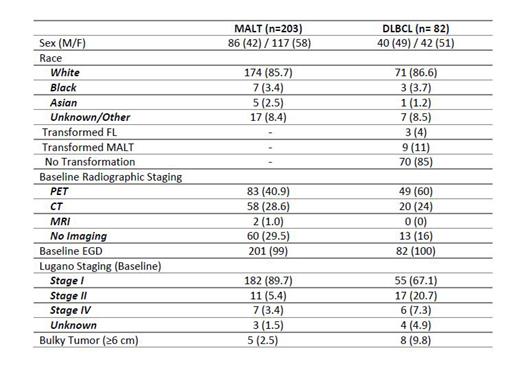Background/Objectives: Our group has recently published its long-term experience treating gastric MALT lymphomas with involved site radiation therapy (ISRT) and supported the use of RT alone as standard of care for H pylori independent MALT. For primary gastric (PG) diffuse large B-cell lymphomas (DLBCL), R-CHOP is the mainstay of therapy, but RT to the stomach primarily as consolidation has rarely been analyzed. In this study, we focus on pts with PG DLBCL who received combined modality therapy.
Materials/Methods: 285 consecutive pts with PG lymphomas treated with RT between 1/2000-1/2021 at our institution were retrospectively identified. Baseline characteristics and follow-up data were abstracted. Overall response rate (ORR) was assessed with Lugano PET criteria and endoscopy. Overall survival (OS) was calculated using Kaplan-Meier. Toxicity was assessed with CTCAE v4.0.
Results: Of 285 pts, 203 (71%) had PG MALT and 82 (29%) PG DLBCL. Baseline characteristics are summarized in Table 1. In the DLBCL pts, 74 (90%) received consolidation RT after limited (3-4 cycles) or full (6 cycles) chemoimmunotherapy (CT), 4 (5%) received RT after 2 lines of CT, 2 (3%) received first line RT followed by CT, 1 (1%) had 3 lines of CT and RT, and 1 (1%) was treated with surgery, 2 lines of CT, and RT. In the 74 pts who received CT+RT as first line treatment, the median RT dose was 3060 cGy (range 1620-3600). Based on post-chemo pre-RT EGD and PET, 61 (82%) pts were in CR, 7 (10%) had PR, 3 (4%) had SD and 3 (4%) pts were not assessed. Overall, 66 (89%) pts who received RT after CT achieved a CR. Of the remaining 8 (11%) pts who did not achieve a CR after RT, 4 had PR, 1 had SD, 1 was lost to FU, 1 started additional CT before response assessment and 1 pt died. The 2 pts in the DLBCL group who received first line RT achieved CR after RT. Side effects after RT were mild and limited to nausea and fatigue. The median follow-up time was 5.4 years (95% CI 0.4, 20.4) in DLBCL pts and 6.3 yrs (95% CI 0.3, 22.1) in MALT pts. The 5-year OS was 80% (95% CI 71-90%) for DLBCL and 96% (95% CI 93-99%) for MALT.
Conclusion: Adding stomach RT following chemoimmunotherapy is feasible, well-tolerated and safe. More in depth analysis PG DLBCL is underway, with a plan to compare outcomes of patients treated with CT alone versus CT followed by RT, and further analyze treatment-related toxicities, progression-free survival, and patterns of recurrence.
Disclosures
Imber:GT Medical Technologies: Honoraria. Yahalom:Convergent R.N.R Ltd.: Other: Provision of Services (uncompensated).


This feature is available to Subscribers Only
Sign In or Create an Account Close Modal